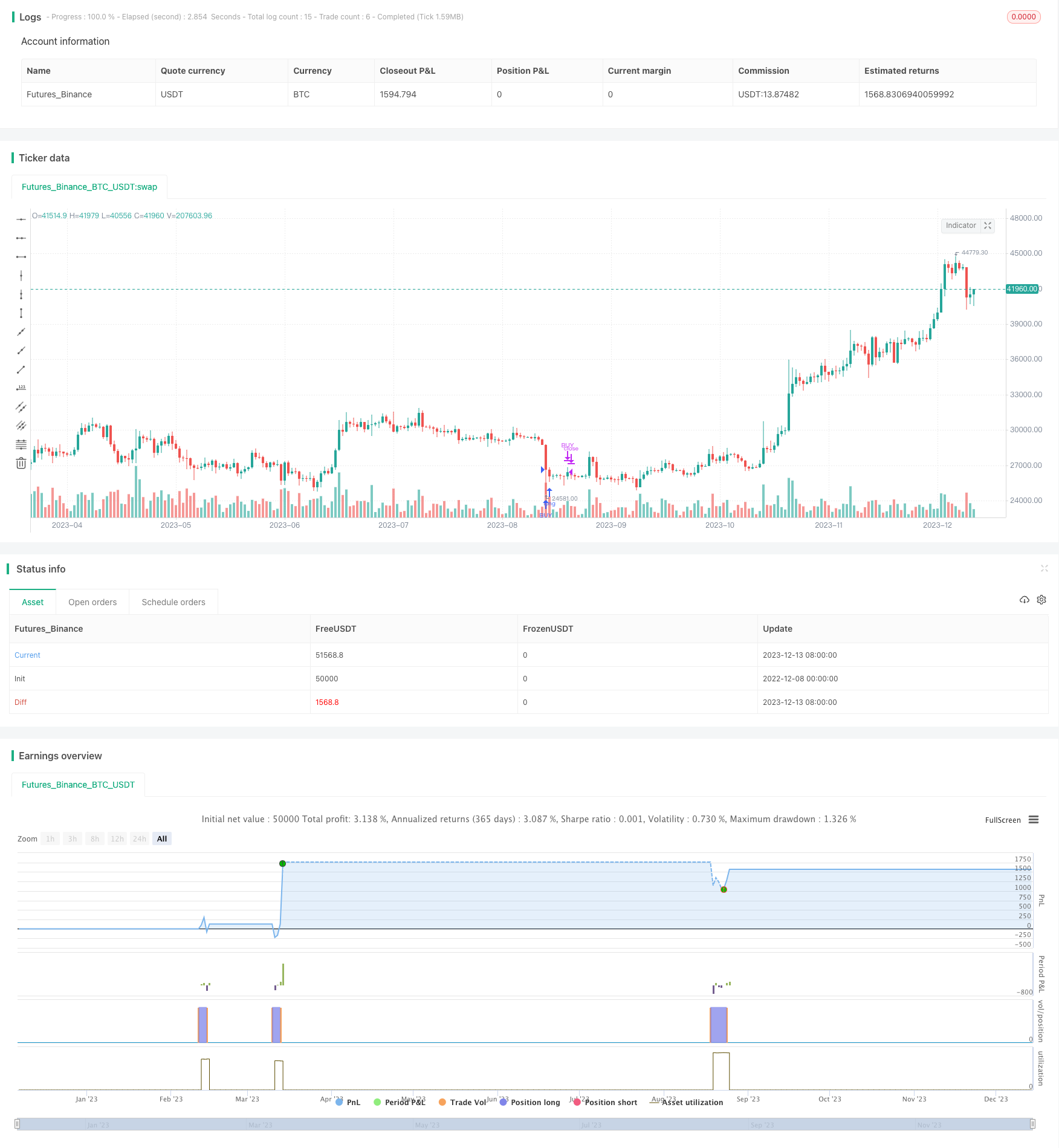HYE Mean Reversion SMA Strategy
Author: ChaoZhang, Date: 2023-12-15 16:51:23Tags:

Overview
The HYE Mean Reversion SMA Strategy is a mean reversion trading strategy using simple moving averages and the relative strength index (RSI). It generates buy and sell signals when the price deviates from the moving average by a certain percentage, combined with RSI indicator filtering. It is a short-term trading strategy.
Strategy Logic
The strategy is mainly based on the following rules:
-
When the 2-period simple moving average falls 3% below the 5-period simple moving average, it is considered the price deviates from the mean and a buy signal is generated.
-
When the 2-period SMA crosses over the 5-period SMA, it is considered the price reverts to the mean and a sell signal is generated.
-
Combined with the exponential moving average of 5-period RSI, buy signals are only generated when RSI is below 30 and sell signals when RSI is above 70, to avoid unnecessary trading.
The main idea is to capture mean reversion opportunities by using short-term price fluctuations. Buy when the price drops by a certain percentage, sell when the price reverts near the moving average, to make a profit. Meanwhile, the RSI indicator can identify overbought and oversold conditions to filter out some noisy trading signals.
Advantage Analysis
The strategy has the following advantages:
-
Simple to implement with low monitoring costs.
-
Captures short-term mean reversion opportunities using price deviation from moving averages. Good backtest performances historically.
-
RSI indicator can effectively filter noise trading and avoid chasing peaks and killing valleys.
-
Flexible parameter adjustment adaptable to different market environments.
-
Supports long only, short only or both directions trading to suit different preferences.
Risk Analysis
There are also some risks:
-
Mean reversion relies on the price reverting to the moving average. There are high stop loss risks if drastic price changes occur.
-
Improper parameter settings may lead to over-trading or missing opportunities.
-
Performance is highly correlated with the market. Underperforms in range-bound and volatile markets.
Countermeasures:
-
Set proper stop loss to control single trade loss.
-
Gradually optimize parameters and evaluate risk adjusted returns.
-
Combine with stock index to enhance adaptivity.
Optimization Directions
The strategy can be optimized in the following aspects:
-
Test different moving average combinations to find optimal parameters.
-
Try incorporating other indicators to identify trends and improve win rate.
-
Add stop loss mechanisms to reduce maximum drawdown.
-
Optimize entry and exit rules to improve profit factors.
-
Adopt machine learning techniques to build adaptive parameters.
Conclusion
The HYE Mean Reversion SMA Strategy is a simple and practical short-term mean reversion strategy. It uses the price deviation from moving averages to generate trading signals, filtering out noise with RSI indicator. It demonstrated good backtest performances. The strategy is easy to implement with adjustable parameters adaptive to different market environments. But the uncertainty of reversion and stop loss risks should be noted, necessitating proper optimization for different market conditions. Overall, it provides a good reference mean reversion strategy template for quantitative trading.
/*backtest
start: 2022-12-08 00:00:00
end: 2023-12-14 00:00:00
period: 1d
basePeriod: 1h
exchanges: [{"eid":"Futures_Binance","currency":"BTC_USDT"}]
*/
// @version=4
strategy("HYE Mean Reversion SMA [Strategy]", overlay = true )
//Strategy inputs
source = input(title = "Source", defval = close)
tradeDirection = input(title="Trade Direction", type=input.string,
options=["Long Only", "Short Only", "Both"], defval="Long Only")
smallMAPeriod = input(title = "Small Moving Average", defval = 2)
bigMAPeriod = input(title = "Big Moving Average", defval = 5)
percentBelowToBuy = input(title = "Percent below to buy %", defval = 3)
percentAboveToSell = input(title = "Percent above to sell %", defval = 3)
rsiPeriod = input(title = "Rsi Period", defval = 2)
rsiLevelforBuy = input(title = "Maximum Rsi Level for Buy", defval = 30)
rsiLevelforSell = input(title = "Minimum Rsi Level for Sell", defval = 70)
longOK = (tradeDirection == "Long Only") or (tradeDirection == "Both")
shortOK = (tradeDirection == "Short Only") or (tradeDirection == "Both")
// Make input options that configure backtest date range
startDate = input(title="Start Date", type=input.integer,
defval=1, minval=1, maxval=31)
startMonth = input(title="Start Month", type=input.integer,
defval=1, minval=1, maxval=12)
startYear = input(title="Start Year", type=input.integer,
defval=2020, minval=1800, maxval=2100)
endDate = input(title="End Date", type=input.integer,
defval=31, minval=1, maxval=31)
endMonth = input(title="End Month", type=input.integer,
defval=12, minval=1, maxval=12)
endYear = input(title="End Year", type=input.integer,
defval=2021, minval=1800, maxval=2100)
inDateRange = true
//Strategy calculation
rsiValue = rsi(source, rsiPeriod)
rsiEMA = ema(rsiValue, 5)
smallMA = sma(source, smallMAPeriod)
bigMA = sma(source, bigMAPeriod)
buyMA = ((100 - percentBelowToBuy) / 100) * sma(source, bigMAPeriod)[0]
sellMA = ((100 + percentAboveToSell) / 100) * sma(source, bigMAPeriod)[0]
if(crossunder(smallMA, buyMA) and rsiEMA < rsiLevelforBuy and inDateRange and longOK)
strategy.entry("BUY", strategy.long)
if(crossover(smallMA, bigMA) or not inDateRange)
strategy.close("BUY")
if(crossover(smallMA, sellMA) and rsiEMA > rsiLevelforSell and inDateRange and shortOK)
strategy.entry("SELL", strategy.short)
if(crossunder(smallMA, bigMA) or not inDateRange)
strategy.close("SELL")
- Momentum Breakout Bi-directional Tracking Strategy
- Super Trend LSMA Long Strategy
- Three Bar and Four Bar Breakout Reversion Strategy
- Adaptive SMI Ergodic Trading Strategy Based on Adaptive Exponential Moving Average Lines
- SMA and PSAR Strategy for Spot Trading
- SMA and RSI Long Only Strategy
- Dual Moving Average Reversal Breakout Strategy
- Trend Following Strategy Based on Ichimoku Cloud
- High Frequency Trading Strategy Based on Bollinger Bands and StochRSI Indicators
- Dual Reversion Balance Strategy
- Dual Moving Average Reversal Strategy
- Dual Direction Price Breakthrough Moving Average Timing Trading Strategy
- Bollinger Breakout Stock Strategy
- Seven Candlestick Oscillation Breakthrough Strategy
- Golden Dead Cross Trend Tracking Strategy
- Quantitative Trading Strategy Based on TRSI and SUPER Trend Indicators
- An Intraday Trend Following Quantitative Strategy Based on Multi-indicator Condition Filtering
- Bollinger Bands and RSI Short Selling Strategy
- Reverse Trading Strategy Based on Overlapping Price Differentials
- Price Deviation from Daily Average Trading Strategy